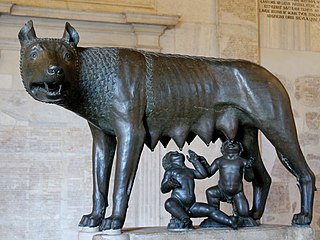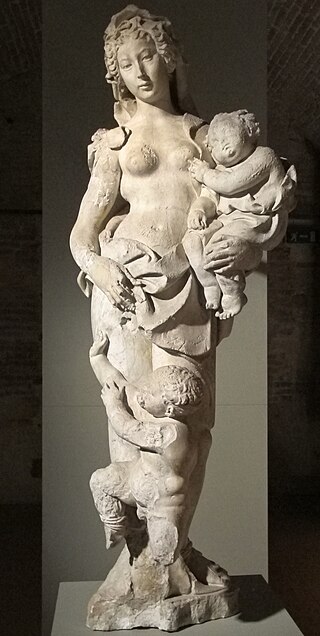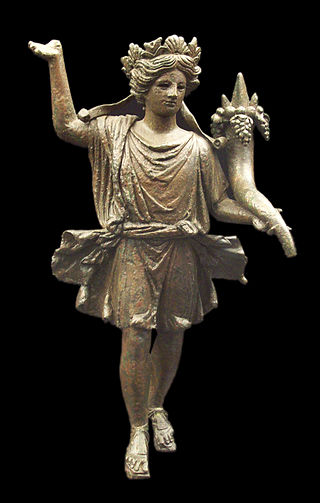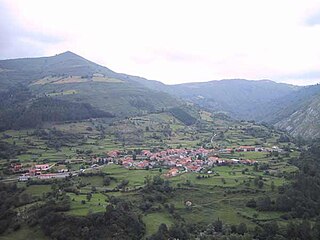Related Research Articles

Lupercalia also known as Lupercal was a pastoral festival of Ancient Rome observed annually on February 15 to purify the city, promoting health and fertility. Lupercalia was also known as dies Februatus, after the purification instruments called februa, the basis for the month named Februarius.

Vesta is the virgin goddess of the hearth, home, and family in Roman religion. She was rarely depicted in human form, and was more often represented by the fire of her temple in the Forum Romanum. Entry to her temple was permitted only to her priestesses, the Vestal Virgins, who guarded particular sacred objects within, prepared flour and sacred salt for official sacrifices, and tended Vesta's sacred fire at the temple hearth. Their virginity was thought essential to Rome's survival; if found guilty of inchastity, they were buried or entombed alive. As Vesta was considered a guardian of the Roman people, her festival, the Vestalia, was regarded as one of the most important Roman holidays. During the Vestalia privileged matrons walked barefoot through the city to the temple, where they presented food-offerings. Such was Vesta's importance to Roman religion that following the rise of Christianity, hers was one of the last non-Christian cults still active, until it was forcibly disbanded by the Christian emperor Theodosius I in AD 391.

In Roman mythology, Romulus and Remus are twin brothers whose story tells of the events that led to the founding of the city of Rome and the Roman Kingdom by Romulus, following his fratricide of Remus. The image of a she-wolf suckling the twins in their infancy has been a symbol of the city of Rome and the ancient Romans since at least the 3rd century BC. Although the tale takes place before the founding of Rome around 750 BC, the earliest known written account of the myth is from the late 3rd century BC. Possible historical bases for the story, and interpretations of its various local variants, are subjects of ongoing debate.

Acca Larentia or Acca Larentina was a mythical woman, later a goddess of fertility, in Roman mythology whose festival, the Larentalia, was celebrated on December 23.

RheaSilvia, also known as Ilia, was the mythical mother of the twins Romulus and Remus, who founded the city of Rome. This event was portrayed numerous times in Roman art Her story is told in the first book of Ab Urbe Condita Libri of Livy and in Cassius Dio's Roman History. The Legend of Rhea Silvia recounts how she was raped by Mars while she was a Vestal Virgin, resulting in the twins, as mentioned in the Aeneid and the works of Ovid.

In Roman mythology, King Numitor of Alba Longa, was the maternal grandfather of Rome's founder and first king, Romulus, and his twin brother Remus. He was the son of Procas, descendant of Aeneas the Trojan, and father of the twins' mother, Rhea Silvia, and Lausus.

In Roman mythology and religion, Quirinus is an early god of the Roman state. In Augustan Rome, Quirinus was also an epithet of Janus, as Janus Quirinus.

The Aventine Hill is one of the Seven Hills on which ancient Rome was built. It belongs to Ripa, the modern twelfth rione, or ward, of Rome.

In ancient Roman religion, the Cerealia was the major festival celebrated for the grain goddess Ceres. It was held for seven days from mid- to late April. Various agricultural festivals were held in the "last half of April". The Cerealia celebrated the harvest, and may have begun on the 19th. Surviving descriptions of Rome's city festival of Ceres are presumably urban versions of an originally rustic, agricultural festival. In his treatise on agriculture, Cato the elder recommends that farmers sacrifice a sow to Ceres, before the harvest.
The Lemuralia or Lemuria was an annual event in the religion of ancient Rome, during which the Romans performed rites to exorcise any malevolent and fearful ghosts of the restless dead from their homes. These unwholesome spectres, the lemures or larvae were propitiated with chants and offerings of black beans.
The Robigalia was a festival in ancient Roman religion held April 25, named for the god Robigus. Its main ritual was a dog sacrifice to protect grain fields from disease. Games (ludi) in the form of "major and minor" races were held. The Robigalia was one of several agricultural festivals in April to celebrate and vitalize the growing season, but the darker sacrificial elements of these occasions are also fraught with anxiety about crop failure and the dependence on divine favor to avert it.

The Parilia is an ancient Roman festival of rural character performed annually on 21 April, aimed at cleansing both sheep and shepherd. It is carried out in acknowledgment to the Roman deity Pales, a deity of uncertain gender who was a patron of shepherds and sheep.

Lares were guardian deities in ancient Roman religion. Their origin is uncertain; they may have been hero-ancestors, guardians of the hearth, fields, boundaries, or fruitfulness, or an amalgam of these.
The celeres were the bodyguard of the Kings of Rome and the earliest cavalry unit in the Roman military. Traditionally established by Romulus, the legendary founder and first King of Rome, the celeres comprised three hundred men, ten chosen by each of the curiae. The celeres were the strongest and bravest warriors among the early Roman nobility, and were the bravest and most loyal soldiers in the army. The celeres may also have originated in the fourth century BC when the Romans adopted cavalry from the Samnites. The name of celeres was generally believed to have arisen from their celeritas, or swiftness, but Valerius Antias maintained that their first commander was named "Celer", perhaps the same Celer mentioned by Ovid as the foreman of the first fortification built around the Palatine Hill; it was he, rather than Romulus himself, who slew Remus after he overleapt the wall. According to some accounts they were infantry; while according to others they included both or were only cavalry.

The Fasti, sometimes translated as The Book of Days or On the Roman Calendar, is a six-book Latin poem written by the Roman poet Ovid and published in AD 8. Ovid is believed to have left the Fasti incomplete when he was exiled to Tomis by the emperor Augustus in 8 AD. Written in elegiac couplets and drawing on conventions of Greek and Latin didactic poetry, the Fasti is structured as a series of eye-witness reports and interviews by the first-person vates with Roman deities, who explain the origins of Roman holidays and associated customs—often with multiple aetiologies. The poem is a significant, and in some cases unique, source of fact in studies of religion in ancient Rome; and the influential anthropologist and ritualist J.G. Frazer translated and annotated the work for the Loeb Classical Library series. Each book covers one month, January through June, of the Roman calendar, and was written several years after Julius Caesar replaced the old system of Roman time-keeping with what would come to be known as the Julian calendar.

Romulus was the legendary founder and first king of Rome. Various traditions attribute the establishment of many of Rome's oldest legal, political, religious, and social institutions to Romulus and his contemporaries. Although many of these traditions incorporate elements of folklore, and it is not clear to what extent a historical figure underlies the mythical Romulus, the events and institutions ascribed to him were central to the myths surrounding Rome's origins and cultural traditions.
Celer may refer to:

In ancient Roman religion, the Flamen Quirinalis was the flamen or high priest of the god Quirinus. He was one of the three flamines maiores, third in order of importance after the Flamen Dialis and the Flamen Martialis. Like the other two high priests, he was subject to numerous ritual taboos, such as not being allowed to touch metal, ride a horse, or spend the night outside Rome. His wife functioned as an assistant priestess with the title Flaminicia Quirinalis.

Celis is a town located in the province of Cantabria in northern Spain.
The gens Silvia was a minor plebeian family at ancient Rome. According to legend, the Silvii were the royal dynasty of Alba Longa, Rome's mother city, and presumably came to Rome when that city was destroyed by Tullus Hostilius in the seventh century BC. Notwithstanding their connection with Rome's foundation myths, the Silvii were plebeians, and hardly any members of this gens played a significant role in history. However, from inscriptions, several Silvii appear to have had distinguished military careers, and Silvius Silvanus was governor of Moesia Inferior in the time of Diocletian.